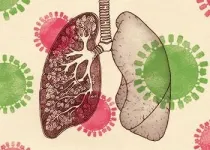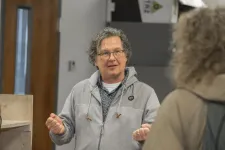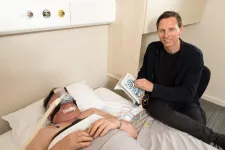Inside the lungs, a new hope for protection against flu damage
New experimental data pinpoints a molecular component responsible for modulating the damage the flu can wreck on the lungs
2021-07-02
(Press-News.org) The seasonal flu kills up to 600 000 people a year worldwide and has a century-long history of pandemics. Examples include the Spanish flu in the late 1910's or the H1N1 in 2009, which together claimed more than 50 million lives. "The way the stage is set tells us that it is not a matter of if but rather of when there will be a next pandemic. And preparing ourselves for that demands intensive fundamental research and constant accumulation of knowledge about these viruses and the diseases they cause", says Maria João Amorim, IGC principal investigator and leader of the team that conducted the study.
When a virus like influenza enters our lungs, it is quickly faced with cocktails of molecules that recognize it and alert the host of its presence. Signals flow back and activate the immune response, calling in an army of cells and inflammation sidekicks. Any exaggeration can destabilize the equilibrium needed to clear the virus and spare our tissues from damage. For most people, clearance arrives a few days after infection and leaves very few traces. But for some, influenza infection entails severe complications, resulting from an exacerbated response that damages the lungs.
"We found that DAF, which stands for decay accelerating factor, aggravates influenza A infection and increases damage to the lungs in mice. This virulence mechanism of influenza, and the molecular regulation that underpins it, are new for us", Maria João Amorim reveals. DAF is a receptor found at the surface of most cells that functions to protect them from being attacked by one of our own immune surveillance systems--the complement. This system protects us against invading pathogens once it detects them in circulation, by inactivating the pathogen itself, or inside infected cells, by mounting a strategy to eliminate them.
"But this can work as double-edged sword because if complement destroys cells from the host, there is the associated danger of provoking excessive self-injury by eliminating too many bystander cells and promoting inflammation. In fact, disease severity and mortality have been associated with both lack or excess of complement activation, which is tuned by regulators such as DAF", remarks Nuno Santos, first author of the study. Contrary to expectations, the team found that influenza A virus exploits DAF to potentiate complement activation as an immune evasion mechanism, increasing the recruitment of immune cells. "By doing so, it can exacerbate the immune response, and this is what damages the lungs. Remarkably, this occurs in a way that is independent of viral load, telling us that it directly affects resilience to infection", says Zoé Vaz da Silva, coauthor of the study.
The role of DAF upon influenza infection can depend on how it interacts with some parts of the virus, leading to more or less aggravated responses. "The complement system is important, but not the only component that determines the outcome of the infection. These interactions have functional implications and are an unprecedented way of a virus, via altering a host protein from within the infected cell, to modulate the immune response. Studying this further in the future is crucial", Maria João Amorim says.
INFORMATION:
This work highlights a novel immune evasion strategy by influenza A virus and stresses the importance of a balanced immune response to viral infections, which allows disease clearance without causing damage. Despite its intrinsic protective role, the immune system can be the cause of severe complications during influenza A infection.
This work was developed at Instituto Gulbenkian de Ciência, in collaboration with Celso Reis from the I3S. Fuding was granted by Fundação para a Ciência e a Tecnologia and Fundação Calouste Gulbenkian.
[Attachments] See images for this press release:

ELSE PRESS RELEASES FROM THIS DATE:
2021-07-02
An international study has elucidated the structure of a protein that is required for the assembly and stability of photosynthetic membranes.
Plants, algae and cyanobacteria convert carbon dioxide and water into biomass and oxygen with the aid of photosynthesis. This process forms the basis of most forms of life on Earth. Global warming is exposing photosynthetic organisms to increasing levels of stress. This reduces growth rates, and in the longer term presents a threat to food supplies for human populations. An international project, in which Ludwig-Maximilians-Universitaet ...
2021-07-02
Researchers based in Munich and Tuebingen have developed an open-source camera system that images natural habitats as they appear to rodents.
During the course of evolution, animals have adapted to the particular demands of their local environments in ways that increased their chances of survival and reproduction. This is also true of diverse aspects of the sensory systems that enable species to perceive their surroundings. In the case of the visual system, these adaptations have shaped features such as the positioning of the eyes and the relative acuity of different regions of the retina.
However, our knowledge of the functional evolution of visual systems in mammals has remained relatively sparse. "In the past 10 or 15 years, the mouse has become the favored model ...
2021-07-02
Elisa Cordero, a doctor at the Virgen del Rocío University Hospital, researcher at the Institute of Biomedicine of Seville (IBiS) and professor in the Department of Medicine at the University of Seville, led a study involving researchers from 12 Spanish hospitals to study the clinical characteristics and facilitate the prognosis of solid organ transplant recipients with COVID-19.
The study provides a more precise description of the complications caused by Covid-19 in organ transplant recipients and has provided useful clinical indicators to identify the disease early. This makes it possible to determine therapeutic and care measures ...
2021-07-02
There are plenty of negatives associated with smart technology -- tech neck, texting and driving, blue light rays -- but there is also a positive: the digital age is not making us stupid, says University of Cincinnati social/behavioral expert Anthony Chemero.
"Despite the headlines, there is no scientific evidence that shows that smartphones and digital technology harm our biological cognitive abilities," says the UC professor of philosophy and psychology who recently co-authored a paper stating such in Nature Human Behaviour.
In the paper, Chemero and colleagues at the University of Toronto's Rotman School of ...
2021-07-02
A new study disputes the prevailing hypothesis on why Mercury has a big core relative to its mantle (the layer between a planet's core and crust). For decades, scientists argued that hit-and-run collisions with other bodies during the formation of our solar system blew away much of Mercury's rocky mantle and left the big, dense, metal core inside. But new research reveals that collisions are not to blame--the sun's magnetism is.
William McDonough, a professor of geology at the University of Maryland, and Takashi Yoshizaki from Tohoku University developed a model showing ...
2021-07-02
Ibaraki, Japan - The flavor of a tomato is an interaction between its taste and aroma. Now, researchers from Japan and the United States have revealed that the pigments that determine the colors of tomatoes also affect their flavor.
In a study published this month, researchers from University of Tsukuba developed a new method to rapidly measure the pigment profiles of tomatoes and used the technique to explore how pigments affect the taste and aroma of different tomato varieties.
The color of tomatoes is produced by combinations of different types of pigments, including carotenoids and chlorophylls. These pigments can also affect the accumulation of flavor-related compounds such as sugars, which affect the taste of tomatoes, and volatile ...
2021-07-02
A surprising study by UNSW on the behaviour of unrelated lizards in very different parts of the world has demonstrated how evolution can lead to different species learning the same skills.
The study in Ecology Letters documents how the Anolis lizard species in the Caribbean, and the Draco lizard species in Southeast Asia, have solved the challenge of communicating with one another to defend territories and attract mates.
It found males from both species perform elaborate head bob and push up displays, and rapidly extend and retract their often large and conspicuously coloured dewlap, or ...
2021-07-02
The muskrat, a stocky brown rodent the size of a Chihuahua - with a tail like a mouse, teeth like a beaver and an exceptional ability to bounce back from rapid die-offs - has lived for thousands of years in one of Earth's largest freshwater deltas, in northeastern Alberta, Canada.
Today, this delta lies within one of the largest swaths of protected land in North America: a national park five times the size of Yellowstone that's home to the planet's biggest herd of free-roaming bison and the last natural nesting ground for the endangered whooping crane. It's also central to the culture ...
2021-07-02
Guadalupe fur seals (Arctocephalus townsendi) have established a large resting colony in the Gulf of California--bringing the total number of sites where this endangered species now occurs to just four. This new haul-out was discovered on El Farallón de San Ignacio Island, along the mainland coast of Mexico, according to researchers from Mexico and the University of British Columbia.
Guadalupe fur seals were hunted for their furs and declared extinct in the late 1800's. However, 14 individuals were discovered on Guadalupe Island in 1950--and the population has grown since then. While still designated as vulnerable to extinction, according to IUCN, the population is believed to total 41,000 individuals and is growing ...
2021-07-02
In an Australian world-first, researchers have successfully repurposed two existing medications to reduce the severity of sleep apnoea in people by at least 30 per cent.
Affecting millions around the world, sleep apnoea is a condition where the upper airway from the back of the nose to the throat closes repetitively during sleep, restricting oxygen intake and causing people to wake as often as 100 times or more per hour.
Those with untreated sleep apnoea are more likely to develop cardiovascular disease, dementia and depression, and are two to four times more likely to crash a car than the general population.
Despite almost thirty years of research, there are no approved drug therapies to treat the condition.
Professor Danny Eckert, Principal ...
LAST 30 PRESS RELEASES:
[Press-News.org] Inside the lungs, a new hope for protection against flu damage
New experimental data pinpoints a molecular component responsible for modulating the damage the flu can wreck on the lungs




